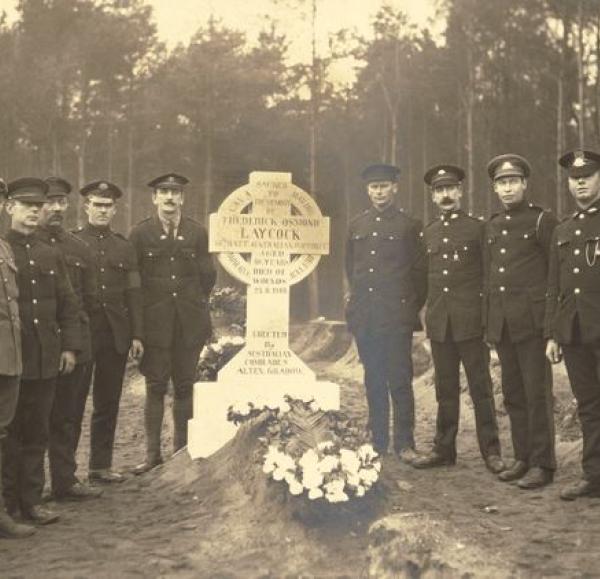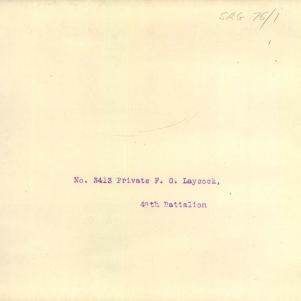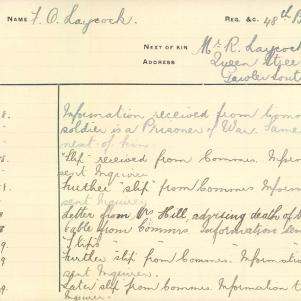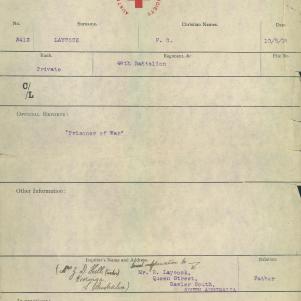From other sources
Your stories
Stories
LAYCOCK, Frederick Osmond
Frederick was born in 1886 in Gawler. His parents were Richard William Laycock and Elizabeth Ann Riggs. Richard owned a business called Laycock Brothers next to the Union Bank on Queen Street, Gawler. They were complete house furnishers and also built cycles and had a 30hp motor on hire. The Laycock family also owned businesses for signwriting, coach painting and monumental works (gravestones ).
Fredrick was a blacksmith. He joined the 48th Battalion and sailed on the “SEANG BEN “ from Adelaide on 10 February 1917. He was admitted to the ship’s hospital for two days and arrived at Devonport, England and sent to Codford to join the 12th Training Battalion. He went to a Shoeing Smith course at the School of Farriery at Romsey and was then sent overseas from Southampton to Havre.
He began fighting there until he was reported ‘wounded and missing’ on 13 April 1918. Frederick was hit in the small of his back by a bullet rendering his legs useless. Soldiers dragged him into a deep shell hole, leaving him under the cover of a white flag.
Group portrait of Prisoners of War (POW) standing beside a grave at the Alten Grabow POW camp, Germany. The elaborate headstone bears the inscription “Sacred to the memory of Frederick Osmond Laycock 48th Batt. Australian Imp. Force Aged 30 Years Died of Wounds 23.8.1918 Erected by Australian Comrades Alten. Grabow.” Inscribed in the circle around the cross is “And how can a man die better”. 3413 Private (Pte) Frederick Osmond Laycock, from Gawler, South Australia, enlisted at the age of 30 on 11 November 1916 and embarked for overseas on 10 February 1917 aboard HMAT Seang Bee. He was wounded and captured at Albert, France, on 3 April 1918 and held as a POW in Germany. Pte Laycock died on 23 August 1918 following an operation to remove a bullet from his back. In 1925 his parents were advised that his body had been exhumed from Alten Grabow POW Cemetery and re-interred in the Berlin South Western Cemetery with a permanent headstone of uniform design. Identified standing third from the right is 2694 Pte Robert Hugh Leister, 53rd Battalion from Parkes, NSW who enlisted at the age of 23 on 17 April 1916 and embarked for overseas on 7 October 1916 aboard HMAT Ceramic. He was reported wounded and missing on 31 March 1917 and later confirmed as a POW. After repatriation to England on 10 January 1919 he reported to the Red Cross "Awaiting transference to Southall. Suffering from gun shot wound in left leg. Up and about.” Pte Leister arrived back in Australia on 10 June 1919. One of a series of over 400 photographs sent by Australian POWs in German camps to Miss M. E. Chomley, Secretary, Prisoners Department, Australian-British Red Cross Society, London. Original album housed in AWM Research Centre at RC00864, Album image number 320.
He was a prisoner of war in Altengrabow, Altemark, Germany. A postcard was received from him on 26/4/1918 saying;
wounded prisoner doing well.
would you please send me outfit of clothes complete also inform my Battalion.
Size of clothes;
4 suit, 63/4 cap, 7-4 boots. ( Sgd. ) FREDERICK LAYCOCK
However a letter was sent to the Red Cross in London from Sergeant Ross at the camp informing them that it was deemed necessary to perform an operation for the removal of a bullet which had lodged against his spine. The operation was a success but he developed Meningitis and died on 20 August 1918.
Frederick was buried with all ceremony and wreathes etc. His parents had been written to and cards and ribbons and photographs of the grave were available for them if requested through the Embassy of Holland. He is buried in the Berlin South, Western Cemetery, Potsdam – Mittelmark, Brandenberg.
Add your story
Have you got some information you would like to share about this person?






